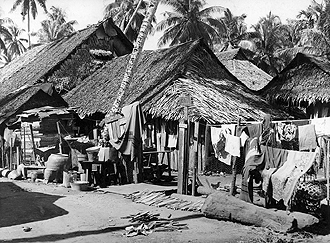Shaik Kadir, Straits Times 22 Jul 09;
THE new Geylang Serai market opened earlier this month - on the very same site as the old one.
The event brought back many memories for me for I lived in Geylang Serai from the age of eight to 21. I had seen it grow from a kampung into a conglomeration of ultra-modern buildings. But it is the area's kampung days that I cherish most for they are associated with the days of my childhood.
After my father died, my mother, my sister and I moved from Chinatown to Paya Lebar and then, in 1954 when I was eight years old, to Geylang Serai. We lived not far away from a kampung mosque, Surau Aminah, now relocated to nearby Jalan Eunos and called Masjid Darul Aman. My mother rented a room in a row of attap houses for $14 a month.
My house had no tap, so I had to collect fresh water from the government standpipe a little distance away. I usually did this at night, carrying two pails. It took a few trips to the standpipe to fill the water-drum in our tiny kitchen area. On my last trip, I would bathe at the standpipe, enjoying the cold water, before returning to my room.
There was an entertainment centre in the area called the Eastern World Amusement Park. It had rides, games galleries and snack stalls. Though the entrance fee to the park was a nominal sum, we children would insist on sneaking into the park through secretly-made holes in the zinc fence.
Beside the park was the Taj cinema, where Tamil, Hindi and Malay movies were screened to packed houses during weekends. We boys found it more fun to watch cowboy and Tarzan films at the open-air cinema located at Jalan Alsagoff. It cost only 10 cents to watch movies there.
Once, as we watched a travelling wagon being set on fire in a cowboy movie, we suddenly realised that the screen was really burning - perhaps because vandals had set it on fire. The show was abandoned, much to our dismay.
Another popular cinema was The Garricks, which showed English movies. Located at the junction of Onan Road and Geylang Road, where The Galaxy is currently located, the cinema screened English and Hindi movies. Its front seats cost 50 cents, as at the Taj, and so we seldom patronised it, though we often went there to look at the photos of the movies being shown.
In front of the Taj, in the area where Northlight School is now located, there were many food and drinks stalls. Men would play sepak raga there, standing in a circle as they used their legs, shoulders and heads to toss a rattan ball to one another.
Nearby, in an open field, we boys would play with tops and marbles. In the kite season during windy April, we would watch young men fly kites and engage in 'kite battles'. Boys carrying salvaging poles would run after the 'losing' kites, often stepping on food spread out to dry on the ground or on roaming chicks. With the curses of residents ringing in their ears, the boys would run away.
Beside the amusement park was a bus terminal fronting Changi Road. The diesel buses plied routes from the city to Jalan Eunos, Kaki Bukit and faraway Changi Point, while the trolley buses, which ran on electricity from overhead electric cables, plied routes from Geylang Serai to the city.
The terminal area was often crowded with people who had made purchases at the popular wet market on Changi Road, where the Joo Chiat Complex is now located. Trishaw riders waited in the vicinity to take housewives with their heavy purchases home to the kampungs nearby.
The terminal was littered with leaves from the many Madras thorn trees in the area - and also with used bus tickets. I would go round with a friend to collect clean used tickets and arrange them according to value, the lowest being 5 cents. We used the tickets to play number-guessing games.
One day, as we were collecting these tickets, my friend found a 10-cent coin. We rushed off to buy a packet of nasi lemak - coconut-flavoured rice with sambal, a piece of cucumber, a tamban fish and a bit of fried egg, all wrapped up in banana leaf, which in turn was wrapped in old newspaper. Between the two of us, the food was gone in no time.
Finding the 10-cent coin was a piece of good luck. But there was another time when I was even luckier. At the edge of the present Malay Village, there used to be four rows of shops. One afternoon, I went to a bookshop there to look at some Malay books. As I was leaving, an elderly man in the shop tapped my shoulder and gave me an old English book.
That book - Grimms' Fairy Tales - stirred my interest in reading, and I went on to read most of the books in the library cabinet in my classroom. I was then a Primary 6 pupil at Telok Kurau Primary School.
Some time in the middle of that year, my principal, Mr Ratnam Sabapathy, a strict man who walked around with a cane in his hand, made an announcement during the morning assembly.
'Singapore now has a Prime Minister,' he said. 'He is Mr Lee Kuan Yew - and he was a student at this school.'
The year was 1959, when Singapore became a self-governing state.
Shaik Kadir, a retired teacher, is a freelance writer.

Geylang Serai: The kampung memories that last a lifetime
posted by
Ria Tan
at
7/22/2009 02:12:00 PM
![]()
labels singapore, singapore-general, singaporeans-and-nature




